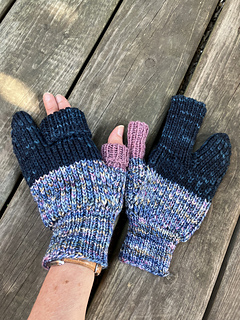patterns > Knitty >  Knitty, First Fall 2025
Knitty, First Fall 2025
> Really Useful Gloves (RUGs)









Really Useful Gloves (RUGs)
I have been in search of the perfect multi-purpose gloves for a long time. I have very long, thin hands so commercially produced gloves nearly always fit poorly. I also enjoy being warm, and not having to take my gloves off to be able to do things.
I don’t think there is actually a glove that is suitable for every single purpose. For instance, this is not a glove for rock-climbing or scuba diving, but it is a very good glove for having your fingers and thumb available when needed, such as for using your phone, putting the lead on the dog, opening gates, cooking up a brew on your camp stove, or taking things out of your wallet. Generally, we use our thumbs, index and middle fingers for these things, and the little and ring fingers are used as props so don’t need the same finesse. So they can stay cosy in their own little home.
These gloves are also ideal for Star Trek fans, as you can encourage people to “live long and prosper” without taking them off. But seriously, having the fingers buddied up in pairs is warmer than having separate fingers, and allows the index and middle finger fabric to be folded down without having bulk between them, allowing greater dexterity.
The main part of the glove is knitted in a tuck stitch, with alternate stitches worked into the row below. This makes a thick, stretchy fabric with a sort of honeycomb pattern on the reverse, which traps lots of air for warmth. The cuff is close fitting to avoid drafts, and the main part of the glove is worked with a little positive ease to trap some extra air, and if it is really cold it allows you to pull all your fingers down inside the glove. The index and ring fingers share a ribbed tube which is open at the tip and can be folded down, and the thumb is also ribbed and can be folded down.
I recommend using a wool or wool blend yarn. You can use scraps of leftovers in plain or variegated yarn.
3685 projects
stashed
2959 times
- First published: June 2025
- Page created: June 6, 2025
- Last updated: September 9, 2025 …
- visits in the last 24 hours
- visitors right now





